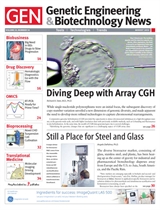Oct 2 2013
Sun Pharmaceutical Industries, through its subsidiary, and Intrexon have formed a joint venture to develop controllable gene-based therapies for the treatment of ocular diseases that cause partial or total blindness.
Dry age-related macular degeneration (AMD), glaucoma, and retinitis pigmentosa are initial targets. Additionally, the companies intend to further expand the future pipeline of targeted ocular diseases to potentially include wet AMD, macular edema, noninfectious uveitis, and diabetic retinopathy. Intrexon and Sun Pharma will share in both the financing of and the revenues from the partnership.
Through an Exclusive Channel Collaboration, the joint venture will leverage Sun Pharma's experience in developing and manufacturing complex dosage forms for niche therapy areas and have access to Intrexon's full suite of synthetic biology technologies, including the RheoSwitch Therapeutic System® (RTS) platform, which the company said is a clinically validated method for controlling the location, concentration, and timing of protein expression. RTS may enable patients to receive a targeted biologic therapy without having to endure a lifetime of injections.
According to Intrexon, current treatments for major ocular disorders require frequent and often painful interventions that, at best, only slow the progression of the disease. "Using our RTS® platform, the goal is to engineer a gene-based ocular treatment in which the concentration, location, and timing of protein expression can be controlled with small molecule therapy," said Samuel Broder, M.D., senior vice president of Intrexon's Health Sector and former director of the National Cancer Institute. "In combination with Sun Pharma's tremendous development and manufacturing experience, we hope to produce a therapy that is minimally invasive as well as maximally effective in treating these debilitating diseases."

 This article was reprinted from Genetic Engineering & Biotechnology News (GEN) with permission from Mary Ann Liebert, Inc., publishers. Genetic Engineering & Biotechnology News (GEN) has retained its position as the number one biotech publisher around the globe since its launch in 1981. GEN publishes a print edition 21 times a year and has additional exclusive editorial content online, like news and analysis as well as blogs, podcasts, webinars, polls, videos, and application notes. GEN's unique news and technology focus includes the entire bioproduct life cycle from early-stage R&D, to applied research including omics, biomarkers, as well as diagnostics, to bioprocessing and commercialization.
This article was reprinted from Genetic Engineering & Biotechnology News (GEN) with permission from Mary Ann Liebert, Inc., publishers. Genetic Engineering & Biotechnology News (GEN) has retained its position as the number one biotech publisher around the globe since its launch in 1981. GEN publishes a print edition 21 times a year and has additional exclusive editorial content online, like news and analysis as well as blogs, podcasts, webinars, polls, videos, and application notes. GEN's unique news and technology focus includes the entire bioproduct life cycle from early-stage R&D, to applied research including omics, biomarkers, as well as diagnostics, to bioprocessing and commercialization.